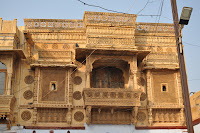(...)
As we walked into the narrow streets of Jaisalmer lined with its intricate carved façades, which still retained their traditional ambience, it was like walking into the 19th century, when these mansions said to have been built by the prominent town's merchants and ministers dominated the mysterious labyrinthine lanes and back alleys of the city.
Most of the time we had to look up as the intricate carvings were on the balconies and windows, though the bustling street life was equally worth being noted for rather distinct reasons.
The "Jalis" (latticed stone screens) displaying a wide variety of patterns are said to have kept the harsh desert sun out, whilst letting the fresh air in, as well as enabling the women to observe the street life without being seen.
The purpose of the "Jharokkas" (projecting balconies) is said to have been mainly decorative, allowing the stonemasons a rather unique opportunity to display their creativity and skill.


According to an expert opinion the sandstone used in these constructions was rather soft when newly quarried gradually becoming harder with exposure, thus making it the ideal material for carving.

Whichever reason may be presented ...the truth is artistry and beauty were everywhere and I couldn't help feeling privileged for having been given the chance of witnessing such grandeur ...
Prior to continuing our "adventure" into the lower part of the city we came across the painted image of the Hindu God Ganesha on quite a few walls and were soon told by our guide that despite the ongoing aura of fecundity and good luck associated to it having it painted on a newly wedded couple's house is believed to bring protection and good fortune.

(To be continued)













No comments:
Post a Comment